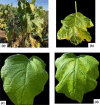Draft genome sequences of 11 Xanthomonas strains associated with bacterial spot disease in Turkey
- PMID: 37424560
- PMCID: PMC10323804
- DOI: 10.1099/acmi.0.000586.v3
Draft genome sequences of 11 Xanthomonas strains associated with bacterial spot disease in Turkey
Abstract
Bacterial spot is an economically significant disease in tomato and pepper-producing countries globally. We report the whole-genome sequence of 11 Xanthomonas strains associated with bacterial spot disease on pepper, tomato and eggplant in the Southeastern Anatolia Region, Turkey. This genomic information can be used as a reference to study the genetic diversity of these species and contribute to illuminating pathogen evolution with respect to host specificity.
Keywords: Turkey; Xanthomonas; bacterial-spot; eggplant; pepper; tomato; whole-genome.
© 2023 The Authors.
Conflict of interest statement
The authors declare that there are no conflicts of interest.
Figures


References
-
- Newberry EA, Bhandari R, Minsavage GV, Timilsina S, Jibrin MO, et al. Independent evolution with the gene flux originating from multiple Xanthomonas species explains genomic heterogeneity in Xanthomonas perforans . Appl Environ Microbiol. 2019;85:e00885-19. doi: 10.1128/AEM.00885-19. - DOI - PMC - PubMed
-
- Araújo ER, Pereira RC, Ferreira MASV, Café-Filho AC, Moita AW, et al. Effect of temperature on pathogenicity components of tomato bacterial spot and competition between Xanthomonas perforans and X. gardneri. In III International Symposium on Tomato Diseases. Acta Hortic. 2011:39–42. doi: 10.17660/ActaHortic.2011.914.3. - DOI
LinkOut - more resources
Full Text Sources
